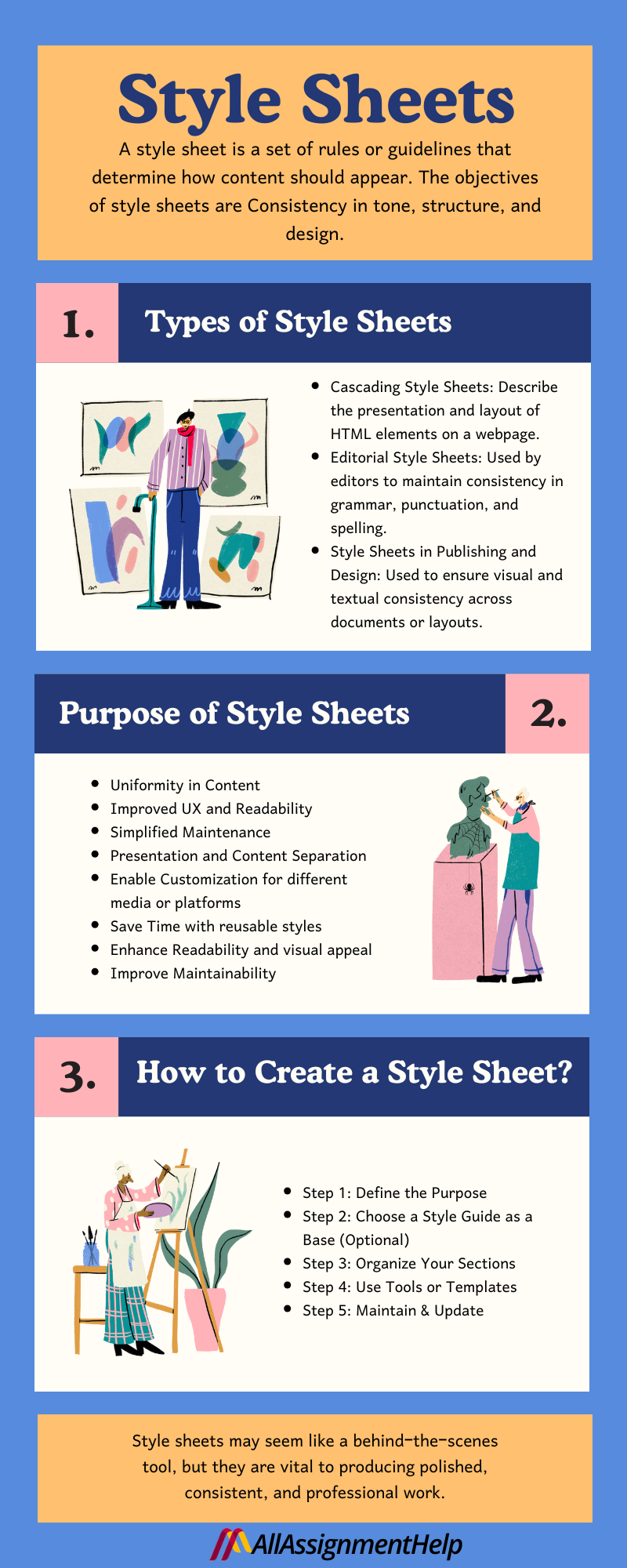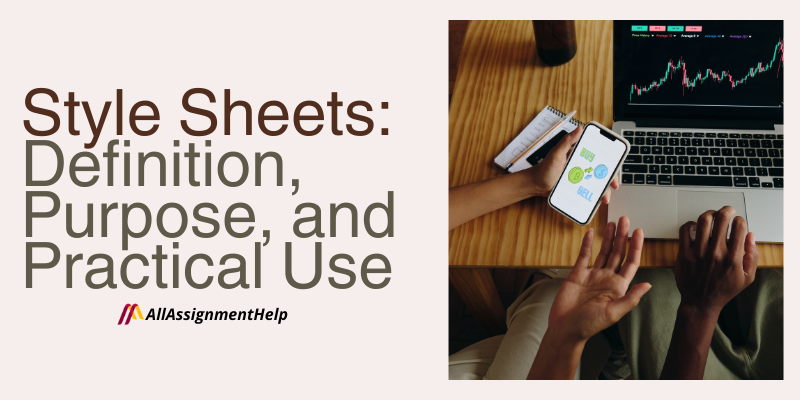Table of Contents
Clarity and consistency are essential whether you are formatting a paper, creating a webpage, or writing a blog. Eliminating mistakes and inconsistencies from the written work is important since it affects a brand and social status. Sure, a few mistakes are OK, but too many distract and damage the sounds, stories, messages, etc. A style sheet is a basic tool that can greatly improve the quality of professional output, lower the number of errors, and streamline the writing and editing process. It assists web developers, content writers, and visual designers in making sure that all of their work complies with certain requirements. However, do you know what a style sheet is, what purpose it serves, or how to use style sheets in writing? Don’t worry! This blog of All Assignment Help will make you familiar with style sheets and how you can use them effectively to enhance your work.
What Is a Style Sheet?
A style sheet is a set of rules or guidelines that determine how content should appear. These rules can be used for any type of written or graphic information, including papers and webpages. Consistency in tone, structure, and design is the major objective of a style sheet.
In simple terms, it is a collection of requirements for the appearance of various textual components, such as spellings, paragraphs, headers, quotations, references, speech, ideas, numbers, and measurements. You can keep track of your preferences while you write, which will help you and anybody else who collaborates with you create a reference sheet.
Students in the humanities and social sciences can enhance their writing and gain an understanding of the values that shape their choices by creating a style sheet. However, it is not always easy to follow the parameters of a style guide, especially if you are working on an assignment. This is where you can get online assignment help from subject matter experts who will help you in completing your assignment in the right style guide format.
Read Here: Persuasive Writing Techniques- A Complete Guide
Types of Style Sheets
There are many different types of style sheets, and each one has a particular role in arranging and displaying content uniformly on print or digital media. Here are the types of style sheets that you must know:
CSS (Cascading Style Sheets)
The way HTML elements show up on the screen in web design is described by CSS. It makes websites easier to maintain and update by helping to keep information and design separate. Developers can change fonts, colors, spacing, placement, and general layout with CSS. You can take HTML assignment help from experts if your assignment requires a CSS format. Furthermore, there are three ways to write CSS:
- External CSS: Linked as a separate file with a .css extension. This is the most efficient and scalable method.
- Internal CSS: Contained within the style tags in the HTML document’s head section.
- Inline CSS: Defined within an HTML tag using the style attribute.
Editorial Style Sheets
The following criteria are provided by editorial style sheets, which are used in writing and publishing:
- Grammar and punctuation
- Preferred spellings (e.g., “email” vs. “e-mail”)
- Tone and voice
- Formatting (headings, bullet lists, citations)
Organizations often develop their own editorial style sheets. However, many also use popular manuals such as the Chicago Manual of Style, APA, MLA, and AP Style.
Style Sheets in Publishing and Design
Style sheets provide the formatting of text components like as headers, body text, and captions in tools like Adobe InDesign, Microsoft Word, and LaTeX. These are known as:
- Paragraph styles
- Character styles
- Object styles
Utilizing these templates guarantees that any modifications can be implemented consistently throughout a document and speeds up formatting. For example, changing a “Heading 1” style in Word instantaneously updates all of the document’s major headings; no manual effort is required.
Selecting the appropriate style sheet to preserve the consistency, readability, and aesthetic appeal of your writing can be made easier if you are aware of the different types of style sheets available.
Purpose of Style Sheets
Style sheets are necessary for both writing and web design. Their main goal is to guarantee control over the way material is presented visually and structurally on print or digital media while maintaining consistency and clarity. Let’s explore what purpose it serves:
- Uniformity in Content: Style sheets guarantee that every piece of content has the same appearance and feel. Furthermore, readers value uniformity in style, font, tone, and formatting across all types of content, including blog posts, whitepapers, and web pages.
- Improved UX and Readability: A well-crafted CSS style sheet guarantees a clear and easy-to-use interface for users of websites. Consistent formatting makes papers and publications easier to read and understand.
- Simplified Maintenance: Do you need to change the font, color, or margin? You can make global changes in a matter of minutes with style sheets. This is very helpful for huge documents and webpages.
- Presentation and Content Separation: A website or document is easier to maintain and update when the display (CSS) and content (HTML or text) are kept separate. This promotes cleaner, more manageable code.
Style sheets play a key role in organizing and presenting online class assignments in a clear and consistent format. They provide consistent fonts, spacing, and layout throughout all assignments, whether they are used in PDFs, websites, or LMS platforms, which facilitates the reading and understanding of the information. However, it is not always easy for students to follow a style guide perfectly. They might need online class help to complete their assignments in a consistent way. There are websites available that will help you write your online class assignments perfectly and logically.

Practical Uses of Style Sheets
Here are the practical uses of style sheets that you must know:
For Web Developers
CSS empowers web developers to:
- Create responsive designs
- Define page layouts and themes
- Set rules for animations, transitions, and user interactivity
For Content Writers and Editors
Editorial style sheets help:
- Maintain tone and clarity
- Avoid redundant corrections during editing
- Speed up the writing process with predefined rules
This is particularly helpful in agency settings where multiple writers contribute content under one brand umbrella.
For Designers and Publishers
Designers use style sheets in publishing tools to:
- Set margins, padding, and spacing
- Define font styles, sizes, and alignments
- Maintain visual hierarchy
Example: In Adobe InDesign, applying a “Body Text” style across chapters ensures uniformity and allows mass updates when needed.
How to Create a Style Sheet?
Whether for writing, web design, or formatting documents, creating and using a style sheet is a powerful way to ensure consistency, save time, and maintain a professional tone. Here is how to create a style sheet for writing:
Step 1: Define the Purpose
Identify what the style sheet is for, i.e., blog posts, website content, academic papers, or marketing materials. Afterward, choose between:
- A general style sheet (for tone, grammar, voice)
- A formatting style sheet (for font, headers, and spacing)
Step 2: Choose a Style Guide as a Base (Optional)
Refer to standard style guides for structure:
- APA / MLA / Chicago Manual of Style (for academic)
- AP Stylebook (for journalism)
- Google Style Guide / Microsoft Writing Style Guide (for digital content)
Step 3: Organize Your Sections
Create clear categories. Example format is given below:
- Tone and Voice: Formal, conversational, witty, etc.
- Grammar & Spelling: Oxford comma, American vs British English, etc.
- Formatting Rules: Bullet points, bold/italic use, heading levels
- Capitalization & Punctuation: Product names, acronyms, dash vs hyphen
- SEO Guidelines: Keyword placement, meta description structure
- Media Usage: Image sizes, alt text, caption styles
- Hyperlinking Rules: Internal/external link formats
- Examples/Do’s & Don’ts: Clear reference cases
Step 4: Use Tools or Templates
You can create your style sheet in:
- Google Docs or Word (for team access)
- Notion, Trello, or Confluence (collaborative tools)
- Plain text or markdown (.txt/.md) for coding or technical teams
Step 5: Maintain & Update
- Assign an owner (content lead/editor)
- Review regularly (quarterly or monthly)
- Add common questions as they arise
A well-maintained style sheet is the backbone of high-quality, consistent content. Whether you are building a blog, writing articles, or even your academic assignments, investing time in creating and using a style sheet ensures you present your best work every time.
Also Read: What is Descriptive Writing? In-depth Guide
Conclusion
Style sheets may seem like a behind-the-scenes tool, but they are vital to producing polished, consistent, and professional work. Whether you are designing a website, writing an article, formatting a brochure, or even writing an assignment, having a style sheet saves time, enhances quality, and ensures consistency. However, if you are a student and lack the necessary style sheet guidelines while working on an assignment, you could ask us to do your assignment for you. Not only this, you can even ask us, take my online exam for me, if your exams are coming closer and you need to score the highest grades in your online coursework. We have experts in all academic areas to assist you and make your academic life easy and smooth.
FAQs
Who should use a writing style sheet?
Writers, editors, journalists, content teams, marketing teams, and students can all benefit from using a style sheet to ensure consistent and professional writing.
How is a style sheet different from a style guide?
A style guide is a published reference (e.g., APA, MLA, Chicago Manual of Style), while a style sheet is a custom document created for a specific organization or project, often based on a chosen style guide.
Can I create my own style sheet?
Yes! You can create your style sheet to suit your project’s needs. Start by identifying the key language and formatting choices you want to standardize.
How do I update a style sheet?
Review and revise your style sheet regularly to incorporate changes in language use, branding updates, or new content types. Version control is important if multiple people use it.
